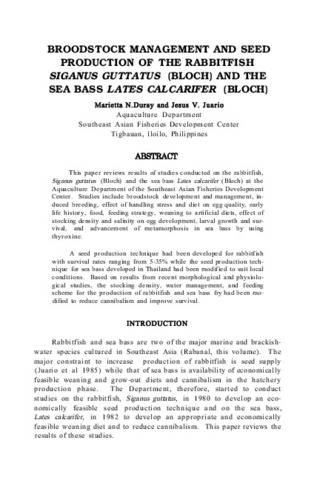Growth, metamorphosis and survival of orange-spotted rabbitfish (Siganus guttatus) larvae fed sodium iodide-supplemented brine shrimp (Artemia sp.)
- Global styles
- MLA
- Vancouver
- Elsevier - Harvard
- APA
- Help

View/
Date
2021-04Author
Page views
2,992ASFA keyword
AGROVOC keyword
Taxonomic term
Metadata
Show full item record
Share
Abstract
In an attempt to improve the hatchery production of orange-spotted rabbitfish (Siganus guttatus), the present study evaluated the effects of iodine-supplementation of larval food (Artemia) on endogenous thyroid hormone (TH) levels in larvae, and subsequently on their metamorphosis, growth and survival. Rabbitfish larvae (20 days after hatching, DAH) were fed unsupplemented (control) and sodium iodide (0.8 g L−1) -supplemented Artemia. The larvae were reared in 250-L fiberglass tanks at a stocking density of five larvae L−1. Each treatment has three replicates. The study was conducted until 50% of the larval population in both treatments has completely metamorphosed. Iodine-supplementation in larval food resulted in significantly higher levels of thyroxine (T4) and triiodothyronine (T3), (TH) in rabbitfish larvae (p < 0.05). Treated rabbitfish larvae had significantly higher mean body weight (0.20 ± 0.01 g) than the control (0.14 ± 0.01 g) and a lower muscle fiber (MF) count (0.003 ± 0.001 MF μm−2) than the control (0.009 ± 0.002 MF um−2) (p < 0.05). However, survival was not different between the two treatments. Furthermore, using the statistical tool probit analysis on the metamorphic period index, it showed that 50% of the population in the control group metamorphosed at 42.4 DAH while 50% of the population in the treated group metamorphosed at 31.2 DAH. Cumulative stress index test indicated a positive response of larvae fed supplemented Artemia (p < 0.05). This study demonstrated that feeding sodium iodide-supplemented Artemia to rabbitfish larvae enhances the endogenous TH levels which in turn accelerates the metamorphosis and improves fish muscle fiber growth and stress tolerance.
Suggested Citation
Legaspi, M. I., Traifalgar, R. F. M., de Jesus-Ayson, E. G. T., Andrino-Felarca, K. G. S., & Mamauag, R. E. (2021). Growth, metamorphosis and survival of orange-spotted rabbitfish (Siganus guttatus) larvae fed sodium iodide-supplemented brine shrimp (Artemia sp.). Aquaculture , 536, 736443. https://doi.org/10.1016/j.aquaculture.2021.736443
Type
ArticleISSN
0044-8486Collections
- Journal Articles [1258]
Related items
Showing items related by title, author, creator and subject.
-
Thyroxine injection of female rabbitfish (Siganus guttatus) broodstock: changes in thyroid hormone levels in plasma, eggs, and yolk-sac larvae, and its effect on larval growth and survival
Ayson, Felix G.; Lam, Tom J. (Elsevier, 1993)The thyroid hormone levels in female rabbitfish, Siganus guttatus, plasma, eggs, and yolk-sac larvae were measured before and after thyroxine (T4) injection in female spawners at doses of 1, 10, and 100 μg ... -
Broodstock management and seed production of the rabbitfish Siganus guttatus (Bloch) and the sea bass Lates calcarifer (Bloch)
Duray, Marietta N.; Juario, Jesus V. (Aquaculture Department, Southeast Asian Fisheries Development Center, 1988)This paper reviews results of studies conducted on the rabbitfish, Siganus guttatus (Bloch) and the sea bass Lates calcarifer (Bloch) at the Aquaculture Department of the Southeast Asian Fisheries Development Center. Studies ... -
Thyroid hormones promote early metamorphosis in grouper (Epinephelus coioides) larvae
de Jesus, Evelyn Grace T.; Toledo, Joebert D.; Simpas, Marissa S. (Academic Press, 1998)The response of grouper larvae to the thyroid hormones, thyroxine (T4) and triiodothyronine (T3), was examined. Two-, 3-, and 4-week-old grouper larvae were reared in seawater containing either ...






